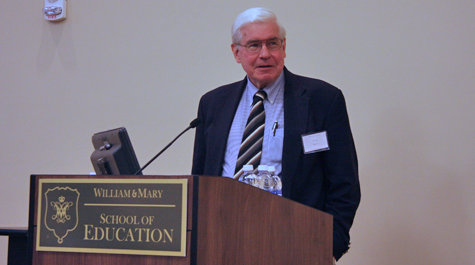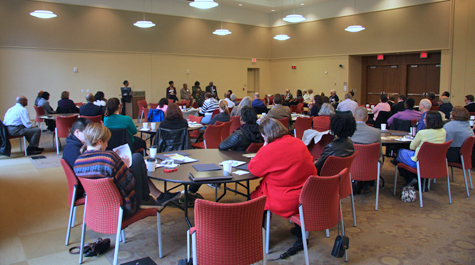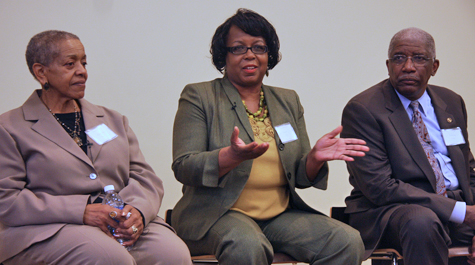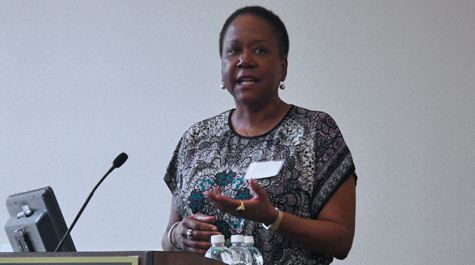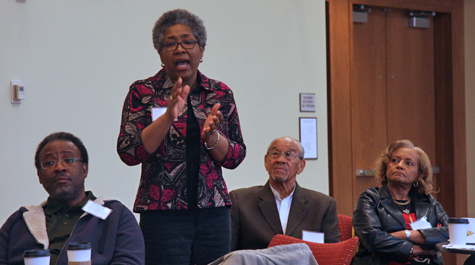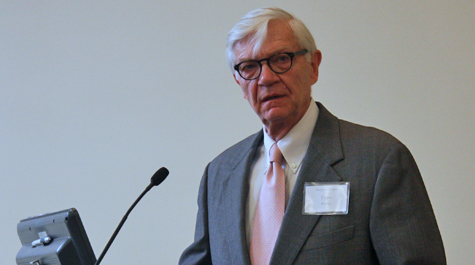Lemon Project honors Bob Engs at third annual symposium
Nearly five years ago, Bob Engs came to William & Mary as a visiting professor of history, conducting research that would serve as the basis for the Lemon Project. Engs passed away unexpectedly in January, but the work that he began goes on as the Lemon Project continues to explore W&M’s history with slavery and Jim Crow and its ongoing relationship with the African-American community.
On Friday and Saturday, the Lemon Project hosted its third annual spring symposium, which was dedicated to Engs’ memory. Held at Bruton Heights School and the W&M School of Education, the two-day event, entitled “Campus & Communities: The African-American Experience Along the Peninsula,” included panel discussions, presentations and a living history performance. More than 150 people, including faculty, staff, students, alumni and community members, attended.
“Facing our past, wrestling with the demons of injustice are not easy tasks … It’s an emotionally wrenching journey, but I think all of us would say that it is a journey that is worth taking if we consider ourselves human beings who value all life and value life equally,” said Kate Slevin, vice provost for academic affairs.
Terry Meyers, co-chair of the Lemon Project with Jody Allen, opened Saturday’s portion of the symposium by reflecting on the Engs’ contributions to the project and the discoveries that have been made since its inception in 2009.
“I think we are making progress in documenting the guilt of the College in enslaving people from its very earliest years,” said Meyers, adding that the College not only utilized enslaved people on its campus in Williamsburg but also on a plantation that provided revenue for scholarships.
“We’re also discovering complexities in our history,” said Meyers, noting the College’s awarding of an honorary degree to England’s most famous and effective opponent of slavery in 1791, the application of a free black person to attend W&M classes in 1807, the beating of a free black person on W&M’s campus in 1836, and the College’s support of the Bray School, an 18th-century institution dedicated to the education of free and enslaved black children.
“All of this and more needs finally to be brought to coherence in a sustained narrative,” said Meyers. “Despite Bob’s passing, that narrative will be written, I am confident, as one more step in the journey of reconciliation that our Board of Visitors, under Bob’s tutelage, designed for the Lemon Project.”
The panelists for Saturday morning’s first session offered their own additions to that narrative. The session, entitled “William & Mary: Then and Now,” featured remarks by current student Brittney Harrington ’15, current staff member Charlotte Brown, community member Tony Conyers and former student Karen Ely ’71. The panel was moderated by Bonnie Winston, communications manager for the Office of Development.
Ely, who was one of the first three residential African-American students at William & Mary, spoke about her first days at the College and the challenges that she faced. She recalled hearing a woman on campus say, “That’s one of the three. She’ll never make it.”
“It made me so angry,” said Ely, who confronted the woman. “I said, ‘Not only will I make it, but I’m going to make sure that every year there’s going to be more people who look like me here.’”
That incident made Ely determined to stay at William & Mary. Despite the challenges she continued to face, Ely said it was worth it “because it allowed students to come behind us.”
Along with the panelists, members of the audience – including alumni, community members and parents of current students – shared their own perspectives during the session, revealing a variety of experiences.
“We’ve come a long way, but we still certainly have a long way to go,” Allen said at the conclusion of the discussion.
“We will be continuing to work, and we will be continuing to ask for your input,” she added.
William & Mary President Taylor Reveley followed the panel session with remarks of his own, thanking the panelists for sharing and lauding the Lemon Project’s work.
“It is vitally important that we do understand William & Mary’s involvement with race from 1693 on and that we do what we can to bridge the gap between William & Mary and the community and to make William & Mary a comfortable place for all members of our community,” he said. “It’s not enough simply to get a powerful education at William & Mary and to pick up a powerful credential, you also need to learn an enormous amount out of class from your peers, and if you are not comfortable being here, it is hard to do.”
Reveley noted that the Lemon Project is an important part of the College’s diversity work, which looks not just at racial differences, but other factors, too, such as nationality, religion and sexual identity.
“If we can’t send students from William & Mary out into the world who are comfortable with people who are different than themselves … then we are not going to send students out who can succeed, because they are going to be working in a world where, if you can’t deal sympathetically and enthusiastically with people of very different backgrounds, perspectives and views, you will not succeed.”
Reveley recalled the lack of diversity in his own undergraduate class at Princeton, in which there was only one African-American: Bob Engs.
The two became friends and remained as such until Engs’ death in January. Reveley was asked to speak at the funeral, and he shared those remarks with the Lemon Symposium attendees on Saturday morning.
“All in all, Dr. Robert Francis Engs was a remarkable man,” said Reveley. “He was an important trailblazer. Bob, too, was my friend for a very long time, and I will miss him.
"We will all miss him, and the Lemon Project will miss him."
















